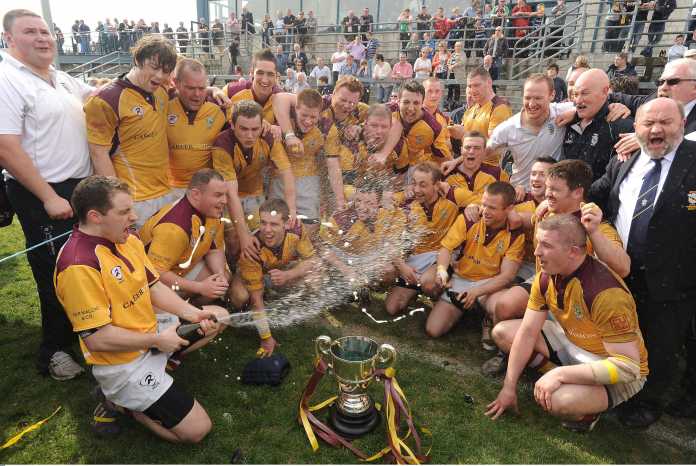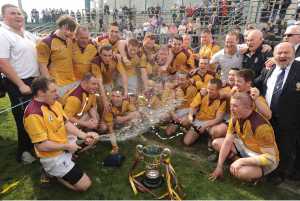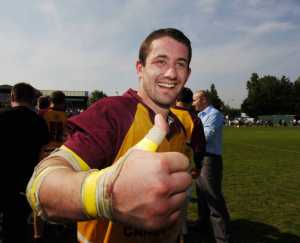
Limerick is famous for its proud rugby tradition. From the early 1900’s to the present day, intense rivalries on the pitch have led to great stories and friendships off it. As part of his series on the seven senior All Ireland League rugby clubs based in Limerick, Daragh Frawley turns his attention to Division 2C side, Bruff RFC.
(Above: 9 April 2011; Bruff team and staff celebrate with the Bateman Cup after defeating Dungannon in Templeville Road, Dublin. Picture credit:Sportsfile)
WHILE they may only be in existence for less than half a century, Bruff Rugby Football Club has certainly made its mark in Irish Rugby landscape.
Founded in August 1970 by two precocious teenagers, there is an interesting back-story to how the Kilballyowen Park club came to be, and Saoirse Clancy recalls it well.
“Current President Nicholas Cooke denies it is the reason that the club was set up but this is the timeline of events.
“In 1968, Bruff and Knockainey GAA teams had amalgamated and were playing against Oola in the minor county final.
“They lost the game but both Willie Conway and Nicholas Cooke left their mark on the game by getting red carded. They got 12-month suspensions for their sins, leaving them to find an alternative sport, which happened to be rugby.
“Again, Nicholas vehemently denies this was why Bruff was setup, but here we are!”
At the age of 19, both Nicholas Cooke and Willie Conway founded Bruff Rugby Club, and they have been ever present in the 46 years since then.
“Nick went to Rockwell College and played rugby with Shannon under 20 in the late 60’s, so there was a strong tradition of rugby with him.
“Willie played GAA at the time and worked in Charleville as an apprentice fitter. He was mingling with fellas from Charleville rugby club, so that’s where the rugby would have come into play for him.
“It was a very different setup from nowadays and the lads were considered very young to set up a rugby club. There was no real animosity but the feeling amongst many was that it wouldn’t last long.
Laying the foundations
The club found its feet quickly, thanks to the support of the local community.
“We owe a great debt of gratitude to the late Lt. Colonel The O’Grady who gave us the grounds for a nominal fee, which was around £2,000 at the time” says club stalwart David O’Keeffe.
“He fought on the beaches during D-Day in Normandy in 1944 and was part of the O’Grady clan. He really was a great supporter of our club”.
Situated in the centre of South County Limerick, Bruff would soon become the focal rugby point for the surrounding rural towns.
“In the early days, we got motoring and I suppose the first real memory on the pitch was getting beaten by Tralee in the Junior Cup semi-final replay in ’75.
“Starting out we had fellas from Hospital, Kilmallock, Croom, Knockainey, Fedamore and a strong nucleus of guys that won St Munchin’s first Munster senior schools cup title in 1968.
“After securing the grounds, the clubhouse was built in 1979 after raising £33,000.
“We were only in existence eight years, and during that time we had a gate lodge where teams would tog out”, explained Clancy.
“When the clubhouse was built, the dance hall was in actual fact two squash courts”, explained O’Keeffe.
“Squash was big at the time and you couldn’t get a game in Limerick unless you booked two weeks in advance. We sold ten year memberships for £100 and people queued up like there was no tomorrow, we actually had to refuse people and there’s people still not talking to us over it!
“There’d be a social every Sunday night and you were allowed 15 every year with a bar extension. As players, we all did the bar in those days helping out the club.
“You’d have hundreds of people coming. Pubs would close at 10pm and then it was ‘everyone up to Bruff!’ Discos couldn’t open until midnight, but as a rugby club we could remain open from 10pm to 2am”.
The importance of community
From its earliest years, the community in Bruff has played a big part in the club, be it on the pitch, or in the background.
Putting the right provisions in place were vital for the club, and Saoirse Clancy explains that the decisions made by the committee at the time have undoubtedly worked in the club’s favour.
“We developed an underage structure back then and it stood to us. It involved a pool of players from the surrounding areas, and luckily those teams allowed us to compete on multiple levels at underage levels.
From under 12’s up, Bruff began to compete and in the late 1990’s the underage teams announced themselves on the national stage.
Winning under 16 and under 18 All-Ireland cups formed the basis of for an assault on the under 20 AIL, which Bruff won in the 2000/01 season.
“Our Under 20s won the All-Ireland that year for the first time. It was unheard of, and all the players had come from within the community.
“We beat UCC in the final in Thomond Park and Steven and Padraig Keogh, who had played with us all the way up in the underage, played against us as they went to Cork on scholarships”.
The club’s ability to produce top class players is one of its distinguishing features.
“You look at guys like Alan Bourke, Stephen and Neilus Keogh and the Cahills, the player pool is very small but the fact that high calibre players keep on coming through is something we’re very proud of.
“We lost a lot of players when we were junior in the early days, but we don’t blame guys for leaving. They were going on to senior teams for the lure of senior rugby, guys like Finbar Hogan, the Keoghs and Eoin Cahill, but they’ve all come back at some stage or another.
“Every club in Limerick came out looking for players when we were junior but when we went senior, they backed off”, explained O’Keeffe.
Going Senior in 2004
Dave O’Keeffe was club president in 2004 and saw the club go from junior to senior status, something which he describes as a momentous occasion.
“We won the round-robin games after winning the junior league and started in division three. In the space of five years, we were in division one and we went on to win the Munster Senior Cup and the Bateman All Ireland Cup for the first time”.
This remarkable rate of progress saw them gain two back-to-back promotions, with a gap of a year before reaching division 1B at the time of the AIL league restructure.
(Above: 28 April 2007; James Taylor, Bruff, celebrates victory in the AIB League Division 3 Final against Wanderers in Templeville Road, Dublin. Picture credit: Sportsfile)
“We were delighted to be playing in 1B, but we struggled big time as a club in terms of sustainability.
“We had five trips up north in the first year and it was very difficult. With a thin squad as well as other factors, it just didn’t work out for us.
“From 1970 right the way through, there has always been a team here. People come and go but we went senior and we have maintained that. We have seen the club through the recession as well as the remarkable route up the divisions and it’s been a pleasure to be a part of it all.
“Last season there were around eight guys from Limerick playing with league winners Wanderers. That shows you the way the game has gone. We were disappointed not to get promoted from 2C. We played Tullamore to get into a playoff but we lost.
Pointing out that it’s not all about trophies, both O’Keeffe and Clancy go back to the mantra of community involvement and producing players to compete at all levels.
Cattle and The Tight Five
“Fellas think when they are coming out here that they’re coming to a different time zone”, joked O’Keeffe.
One particular story that sticks out for Saoirse Clancy involves lock Forward Alan Bourke in his underage days.
(Above 9 April 2011; Glen Sinnamon, Dungannon, is tackled by Alan Bourke in the 2011 All-Ireland Bateman Cup Final. Picture credit: Sportsfile)
“We went into Thomond for an underage match and a fella by the name of ‘Horse’ Cronin was the Thomond coach.
“He was a grand fella and did great work for the underage there, but in Bruff we had what could be described as huge underage players at the time.
“Around the same time there was a witch hunt for farmers who were giving growth promoters to their cattle. After the game, Horse said to the Bruff coach Mickey Cahill, ‘I know your giving it to them Mick, but I just want to know how much. You wouldn’t want to overdo that stuff!’
Dave O’Keeffe recalls a mix up in the pack as one of his funnier memories.
“When Nicholas Cook was coaching, he would always pick big fellas, but in this particular game the front row and second row had never played those positions before.
“No one knew what they were doing, and the front row that played didn’t turn up to training the following week.
“We then found out that the second row cycled in to Thomond Park the following week to see what he was doing wrong.
“He asked Nick ‘where do I put my head for the scrums’, and Nicholas replied, ‘between the prop’s legs’.
“He had in actual fact meant in between the front rows hips, but the second row did it arse ways.
“The front row never played again but went on to have several children!
The Highs and Lows
There have been some incredible highs in the history of Bruff RFC. From the huge crowds in Kilballyowen park for the AIL and their magical cup run to gaining senior status, but for Clancy winning the senior cup in 2011 tops all of that.
“We went on to win the Bateman Cup that year but beating Shannon, Cork Con and Garryowen en route to the Munster Senior Cup was special.
(Above: 2 January 2011; Bruff captain Cathal O’Reagan lifts the cup after victory over Garryowen in the Munster Senior Cup Final, Picture credit: Sportsfile)
For O’Keeffe, it was John ‘Bull’ Hayes getting his first cap for his country.
“Seeing John Hayes selected to play for Ireland is my proudest day as a Bruff man.
“I had heard rumours the week before that he was going to play against Scotland and I got a few notes ready for the press in case it happened.
“I sent the famous Bill McClaren a few things too, and during a lull in the game while there was an injury, he read everything out word for word!”
With incredible highs come lows and for both men losing the Junior cup final to Nenagh in 2004 was very tough to take.
Both also pointed out the passing of former Captain James Keating as a very difficult time in the club.
“James dropped dead on the pitch in 1986 during a training session and it was a horrific time for the club.
A view to the future
When both Clancy and O’Keeffe were asked of what they thought of the future for the AIL, both had mixed feelings.
For Clancy, the opportunity to play in the AIL was, and still is, too good to pass up.
“We came from the junior setup much like Thomond did, and the opportunity gave us great belief in the rugby system.
We started in the Munster Junior 2 league and it’s been an incredible journey since then. I’ve had fantastic times travelling all over Ireland and I still enjoy it immensely.
In ten years, who knows? We want to encompass the amateur belief and do as well as we can. We don’t see ourselves competing with Cork Con or Shannon but we certainly wouldn’t turn down a crack at them.
We’re all about sustainability with the grounds we have and the teams we have.
For O’Keeffe, the All Ireland League was better in times gone by.
“Limerick is a special place when it comes to rugby, and we love to be part of the rivalry and the sporting community.
“We’re an established team now and the success that we’ve had came from within.
“We used to play on a Sunday and there was no going home until closing time!
“It’s a lot more serious nowadays, but the time we had back then was gold.
“Clubs in Limerick and elsewhere are struggling to put up a seconds team at the minute. Guys want to play senior AIL in division one or nothing.
“You can’t blame them for being ambitious but fellas come out of school and if they don’t get to the top level straight away, they stop playing and this is very worrying.
“We have a great under 18 team but they’ll go to the third level in either Waterford, Cork, Galway or Dublin and take a job wherever they can.
“Education comes first so it’s a difficult cycle but again you can’t begrudge guys as it’s an amateur game at the end of the day.
“In terms of the wider game, the drop-off rate is alarming”.
However, they remain optimistic about the future of rugby in Bruff.
“The sport is deeply embedded in the community and there will always be people coming through the gate to tog out at all levels.
“From under 10’s up we are going seven nights a week here in the club.
“Obviously raising finances can be an issue, as it is with all clubs, but everyone rows in and we all do it in the name of Bruff RFC.
Being a Bruff man
For Clancy, being a Bruff man means everything.
“I am privileged to have been given the opportunity to experience the game of rugby and all that comes with it here in Bruff. Being here has helped me create friendships far and wide and this rugby club means everything to me. When I’m away from it I miss all that comes with it”.
For O’Keeffe, it is seeing every step of the remarkable progression of a club that is only 46 years in existence.
“l was here in 1970 when it all began. When it was just green fields with not even as much as a railing around the pitch. We didn’t have much but we had a barbecue that night and that’s when the fun started. I never played here but being part of the club is unreal. I am very proud of what we’ve achieved here in Bruff, and also of what the game of rugby does for people”.






